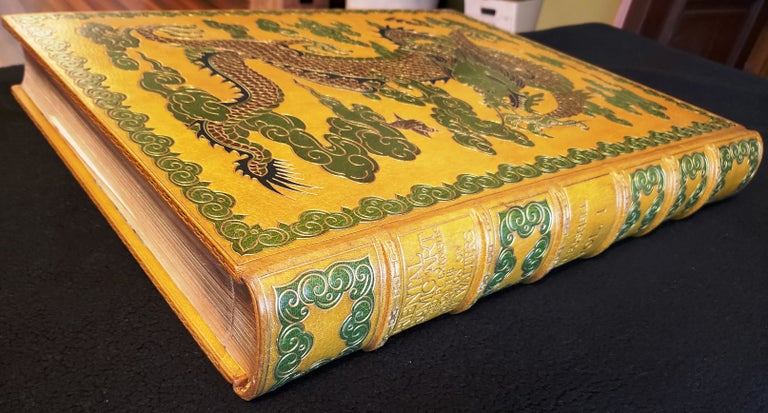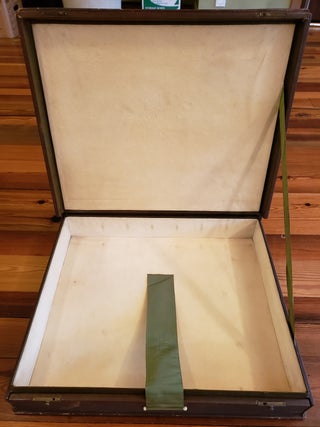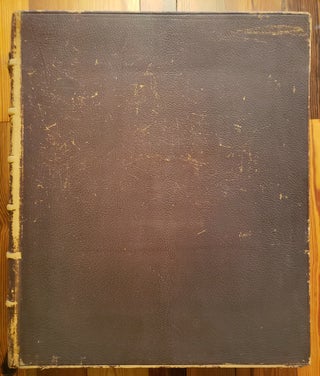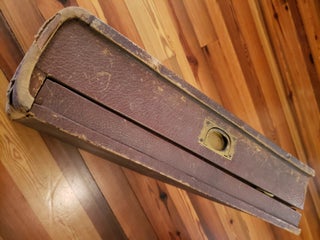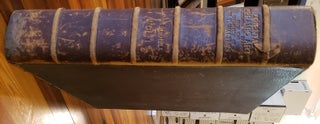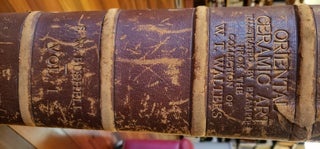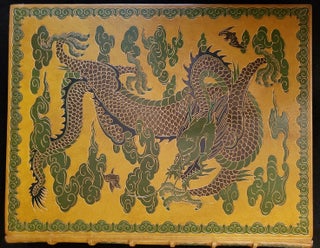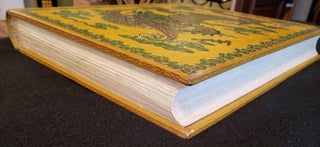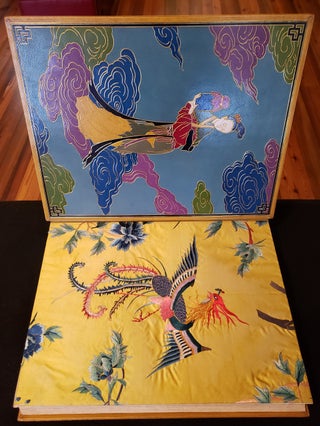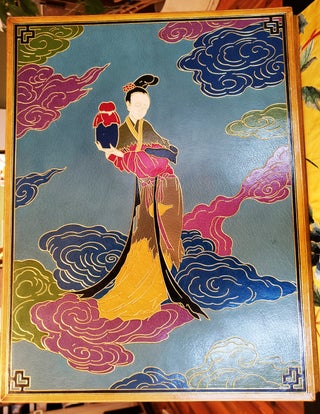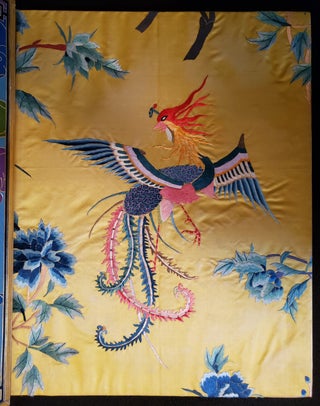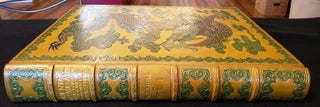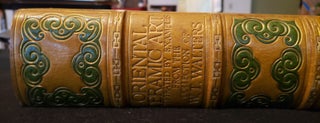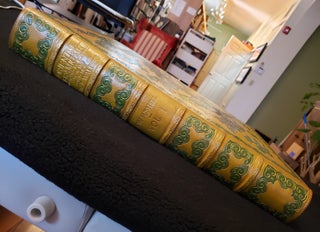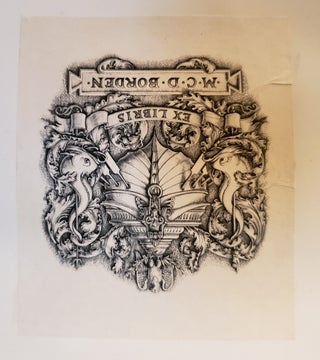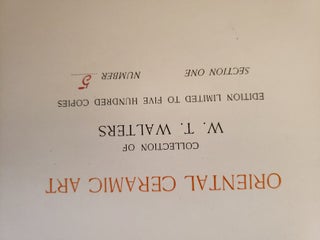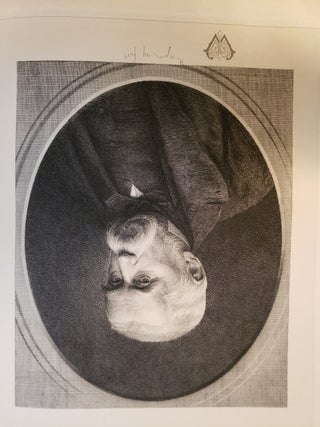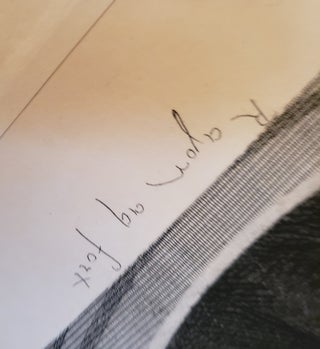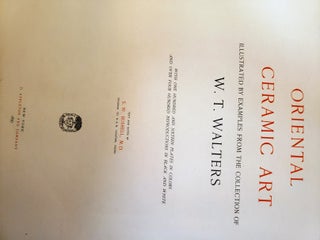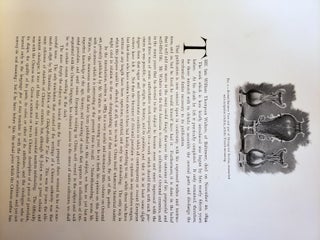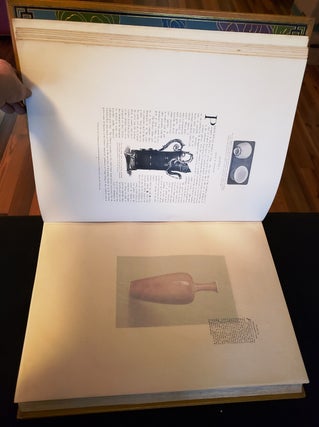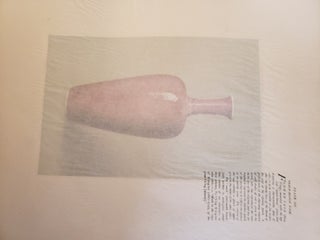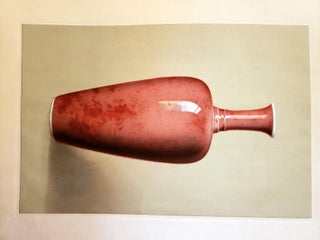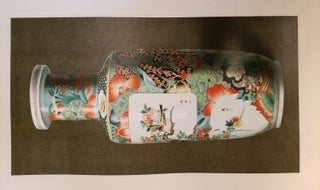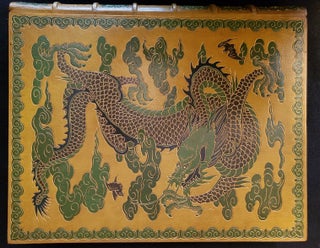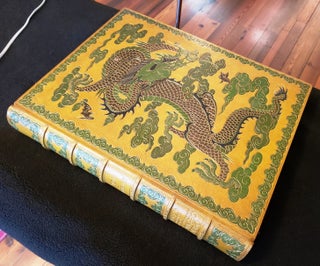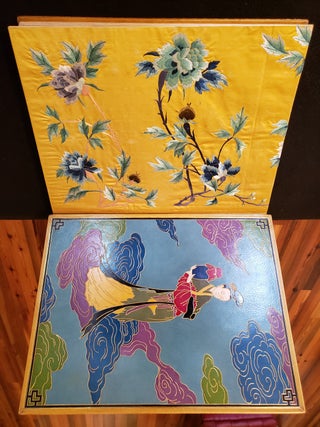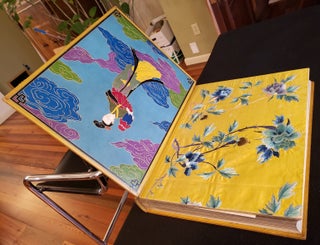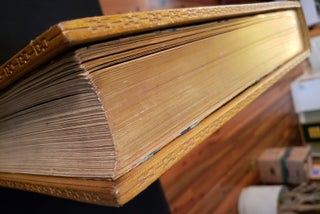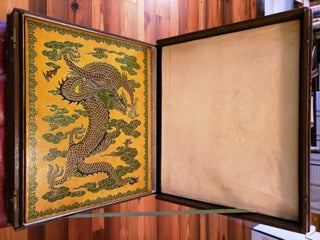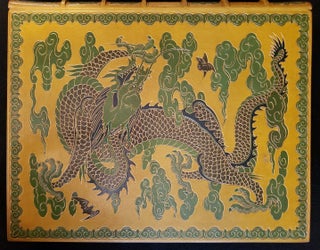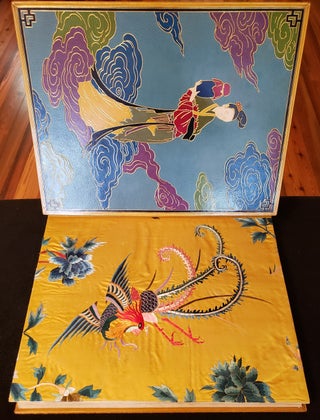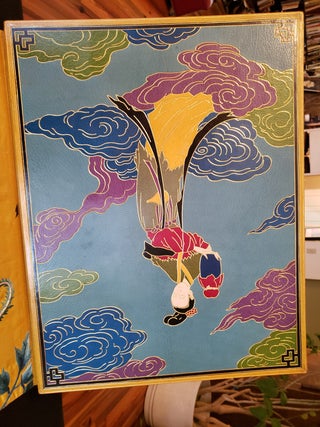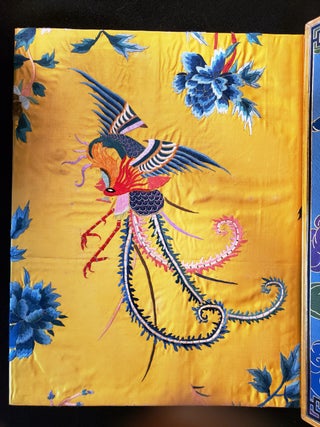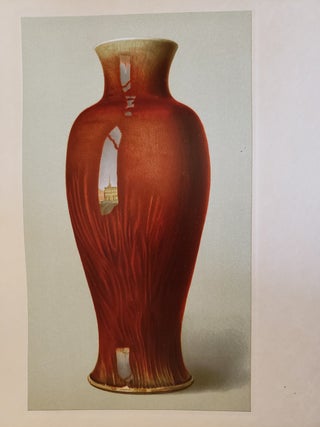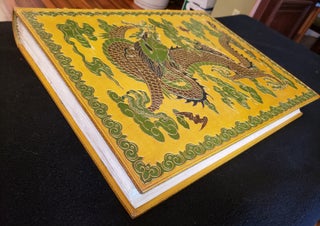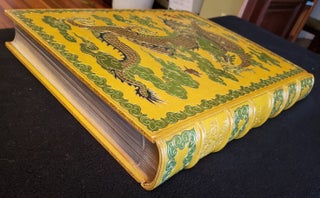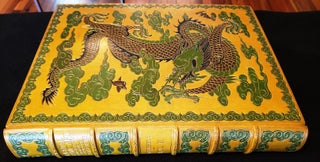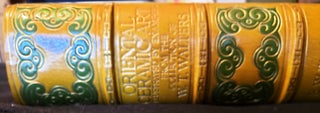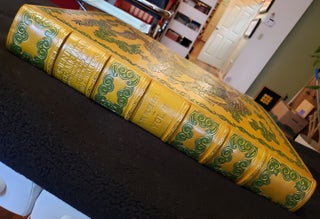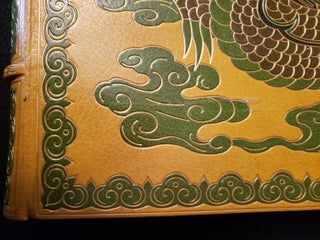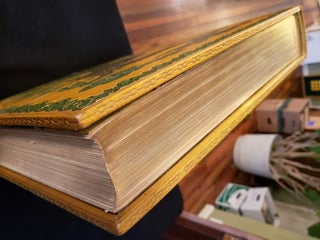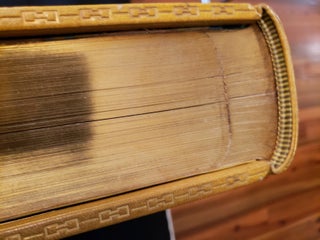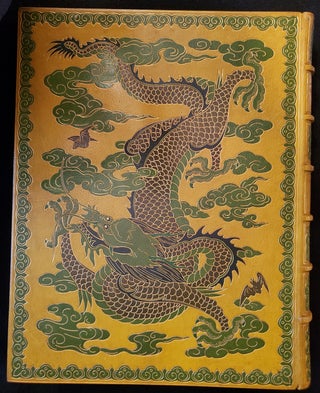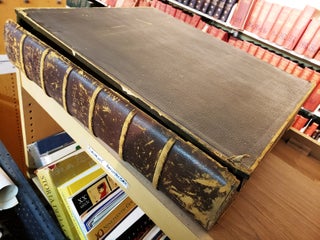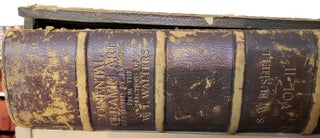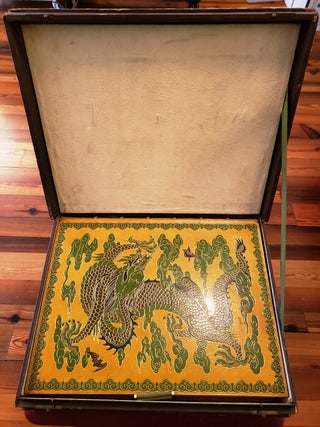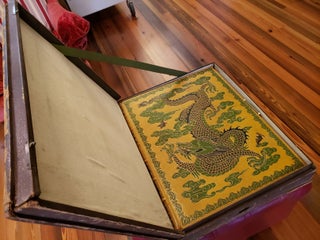Oriental ceramic art illustrated by examples from the collection of W. T. Walters
New York: D. Appleton, 1897. Limited to 500 (likely less). Leather bound. An extremely fine and possibly unique set of this monumental work (22.5" x 18.25" x 3.4" and 43 pounds for EACH volume, and 24.5" x 21" x 3.9" and 15 pounds EACH of the two boxes). Described in 1913 as follows: EDITION-DE-LUXE. Limited to 500 numbered copies, of which this is No. 5...Full yellow crushed levant morocco, with a great Chinese dragon on the covers inlaid in four shades of green surrounded by floating clouds and flying bats inlaid in green on a yellow ground, and all elaborately gold-tooled in a Chinese design; doublure of light blue crushed levant with an inlaid figure of one of the Divinities of the Taoist cult standing on a band of floating clouds and holding a jar in her hands, the whole inlaid in blue, purple, green, red, black, brown, yellow, and white morocco, and gold-tooled, flies of yellow Oriental silk with a Chinese design of an adjutant bird and peony flowers and leaves beautifully embroidered in most brilliantly colored silks, gilt top, uncut, by Riviere. lviii+429 pp with 116 mounted color plates each with letterpress tissue guards identifying the object in the color plate, and 411 text illustrations within the two volumes. Etched frontispiece portrait of W.T. Walters by Rajon. Separate (and much smaller) text volume: S. W. Bushell, Oriental ceramic art, 4to, original red cloth, xiii+1+942 pp. no illustrations. VG++ books, the boxes need some restoration with one lid being broken off the box at the hinge. Item #174111
Perhaps the finest known set of this production. With the bookplate of M.C.D. Borden in each volume, this set was sold at the auction of his library on February 17, 1913 as Lot 125 in Part 1. The boxes are not described in this lot listing, but are constructed of leather over wood, with gilt lettered title in the second compartment of the faux-banded leather spine that constitutes one side of the boxes. There is a faded velvet lining to each box with minor flaws and staining. The books are in a stunning state of preservation.
The books record ceramics from the collection of William Thompson Walters (1820-1894) who was a celebrated devotee of art. William Walters was appointed Art Commissioner from the United States to the Paris Exposition Universelle of 1867 and 1878, and to the Vienna exposition in 1873. The text is written by Stephen Wootton Bushell (1844-1908), a physician to the British legation in Beijing whose writings made him one of the most important foreigners in promoting the understanding of Chinese ceramics in the Victorian period. In 1883, he was appointed by the Victoria and Albert Museum to buy Chinese ceramics, and in total Bushell purchased 240 pieces for the museum.
In 1889, William Walters commissioned Louis Prang & Co., the foremost practitioners of the art of chromolithography, to reproduce choice examples of Chinese porcelain from his extensive collection. Chromolithography, now called color lithography, is a printmaking technique that uses a separate stone for each layer of color needed to produce the finished print.
As important as it is in the literature of oriental ceramics (important text by Bushell about Asian Ceramics, focusing primarily on Chinese imperial and export wares), another major importance of this great work is in the field of American chromolithography. It was the greatest test of Prang's skill as a lithographer. Katharine McClinton writes (in The Chromolithographs of Louis Prang): Three artists, including James Callowhill, worked for seven years producing paintings of the porcelains from which the color lithographs were made. Each plate required from twenty to forty-four separate stones." An excerpt from the introduction to this set further exclaims "The plates in color with which this work is illustrated were made by Louis Prang, of Boston. The work of every European house of importance was examined before Mr. Prang was asked to make lithographs of three pieces of porcelain of different colors - his immediate success determined the question, and when two years later some twenty of the plates were shown to French lithographers in Paris, their criticism was that the impressions had been fortified by color from the brush; they could not believe that work of such excellence could be produced by simple lithography. This very satisfactory opinion has been since confirmed by many lithographers, and it is conceded that these plates represent the highest type of work that has been produced in that branch of art." The production of the book took nearly sixteen years and brought together some of the nation’s finest artists and craftspeople.
It is unknown how many sets were printed, nor how many sets may have been bound such as this, or whether Borden was the original owner of this set. This is because the Great Baltimore Fire of February 7-8, 1904 destroyed nearly all of the business records of Walters, though his art collection in the northern part of the city was unscathed. As with the limited editions of privately published books on jades by Heber Bishop, dated 1906, the majority of Oriental Ceramic Art books were presumably given to major institutions, heads of state and friends of the collector.
The original 1913 auction catalogue (original copy included with this set) described this as a Riviere binding. Riviere bindings of such size and intricacy are very rarely encountered and render this set of books a magnificent work of art unto itself.
Typically, this set is comprised of ten volumes of bound sheets. The sheets are each individually bound with cloth or silk tape to the bound edge of a short piece of paper, insuring a smooth and luxurious experience when opening the book and passing the pages from right to left. I have also seen this publication issued in ten parts which were comprised of loose sheets inserted into a portfolio of similar cover design as this set. These editions appear to have an orange binding tape along the bound edge of the boards, as well as folding flaps to keep the sheets within the covers.
Oriental Ceramic Art by Dr. Stephen W. Bushell, is both a catalog of a collection and a work of art unto itself. When the book was released it immediately set a new standard for both the understanding of East Asian ceramics and for the art collection catalogue. To this day it remains a monument of great importance in the history of chromolithography and documents the foundation of one of America’s greatest collections of Asian porcelain. The shipping weight on this set will be around 130 pounds.
Sorry, this book is not available.
Notify me when this comes back in stock.


